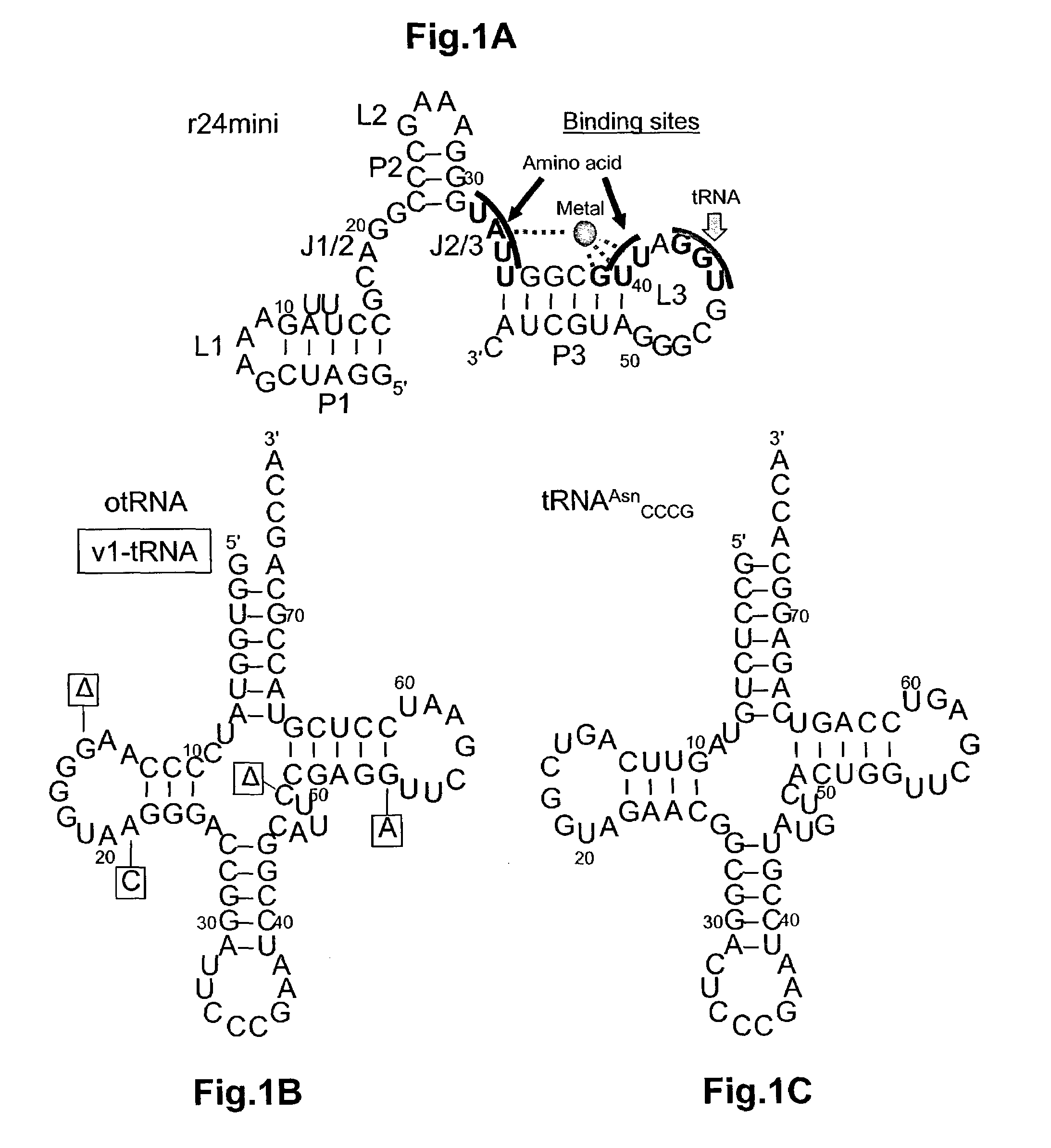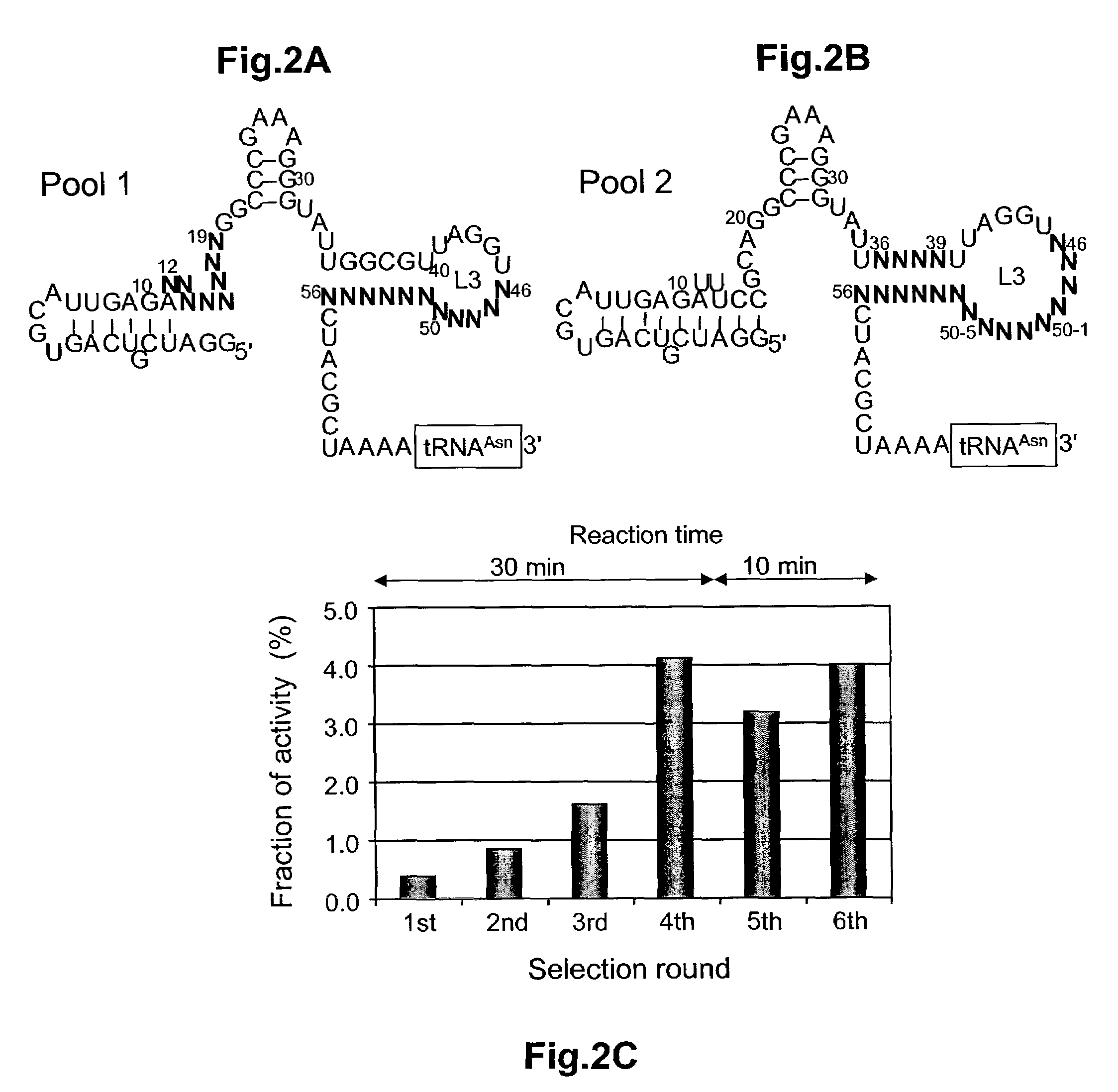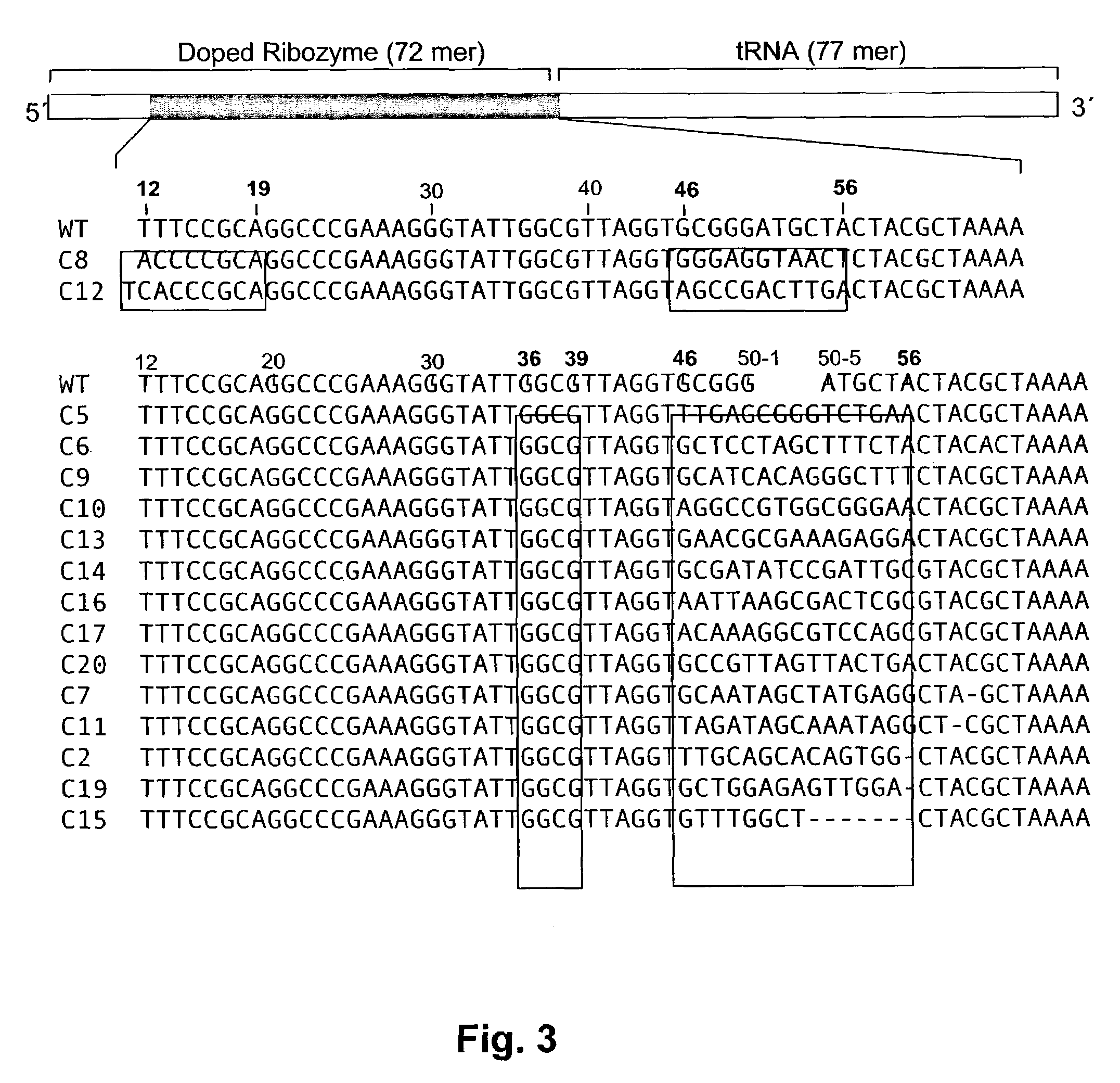Ribozymes with broad tRNA aminoacylation activity
a ribozyme and aminoacylation technology, applied in the field of catalytic rna molecules, can solve the problems of inability to achieve the engineering of arss with desired specificities toward non-natural trnas and amino acids, high cost and inefficiency of such synthesis,
- Summary
- Abstract
- Description
- Claims
- Application Information
AI Technical Summary
Problems solved by technology
Method used
Image
Examples
example 1
[0073]This embodiment describes the isolation of the ribozymes of the present invention.
[0074]Selection reactions. Selection reactions were carried out under the following conditions: 50 μL (100 μL in the first round) of 1 μM RNA pool, 2.5 mM biotin-Phe-CME, in EK buffer [50 mM N-(2-hydroxyethy)piperazine-N′-(3-propanesulfonic acid); EPPS, 12.5 mM KCl pH 7.5], 100 mM MgCl2 and 5 % ethanol. The procedure is as follows: The pool RNA was heated at 95° C. for 3 min and cooled to 25° C. over 5 min. MgCl2 (100 mM for final concentration) was added, followed by a 5 min equilibration. The reaction was initiated by addition of Biotin-Phe-CME in ethanol:water (1:1), and incubated for 30 min (10 min for 5th and 6th rounds). The reaction was stopped by addition of 2 vol of ethanol, and the RNA was precipitated. The RNA pellet was rinsed with 70% ethanol three times, dissolved into EK2 buffer (50 mM EPPS, 500 mM KCl pH7.5), and then 4 units of RNase inhibiter and 4 μL of streptavidin-agarose wer...
example 2
[0095]Immobilizing a ribozyme on a resin is further demonstrated herein using the r24mini as an example of immobilization of any ribozyme on a resin, which is accomplished by taking advantage of the chemical structure of RNA. Periodate oxidation of the 3′-cis-diol on the ribose of RNA yields the corresponding dialdehyde. This functional group allows the immobilization of the RNA on an inexpensive hydrazide resin, and reductive amination makes the interaction an irreversible linkage. (FIG. 8A). To avoid compromising the ribozyme's integrity and activity due to perturbation of the requisite catalytic fold by the resin surface, the r24mini was engineered to bear an additional 20-nt adenosine linker at its 3′-end (r24miniA20 (SEQ ID NO:46); FIG. 8A). This modification did not affect on the catalytic ability in solution (FIG. 9A, lane 4). Thus, this engineered r24mini ribozyme was readily immobilized on the hydrazide resin at the designated site of the ribozyme.
[0096]The resin derivatize...
example 3
[0100]The following embodiment demonstrates the synthesis of a polypeptide having at least one desired amino acid at a selected position.
Methods
[0101]Preparation of ribozymes and tRNAs. The following polynucleotides were chemically synthesized and purified by 6% denaturing PAGE: Fx (5′-ACCTAACGCC AATACCCTT TCGGGCCTGC GGAAATCTTT CGATCC-3′) (SEQ ID NO:38), P5-1 (5′-ACGCATATGT AATACGACTC ACTATAGGAT CGAAAGATTT CCGC-3′)(SEQ ID NO:39), P5-2 (5′-GGTAACACGC ATATGTAATA CGACTC-3′)(SEQ ID NO:40), P3-1 (5′-T20 ACCTAACGCC AATACCCTTT-3′)(SEQ ID NO:41), P3-2 (5′-T20 ACCTAACGCC -3′)(SEQ ID NO:42), P5-3 (5′-ACGCATATGT AATACGACTC ACTATAGCCT CTGTAGTTCAG TCGGT-3′)(SEQ ID NO:43), P3-3 (5′-TGGTGCCTCT GACTGGACTC-3′)(SEQ ID NO:44), tR (5′-TGGTGCCTCT GACTGGACTC GAACCAGTGA CATACGGATT XXXAGTCCGC CGTTCTACCG ACTGAACTAC AGAGGC-3′, XXX=TAG )(SEQ ID NO:45) or GGGT (SEQ ID NO:60).
[0102]The template DNA encoding the ribozyme sequences was amplified by PCR using the corresponding 5′- and 3′-primers (P5-1 and P3-1), a...
PUM
 Login to View More
Login to View More Abstract
Description
Claims
Application Information
 Login to View More
Login to View More - R&D
- Intellectual Property
- Life Sciences
- Materials
- Tech Scout
- Unparalleled Data Quality
- Higher Quality Content
- 60% Fewer Hallucinations
Browse by: Latest US Patents, China's latest patents, Technical Efficacy Thesaurus, Application Domain, Technology Topic, Popular Technical Reports.
© 2025 PatSnap. All rights reserved.Legal|Privacy policy|Modern Slavery Act Transparency Statement|Sitemap|About US| Contact US: help@patsnap.com



